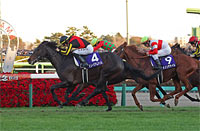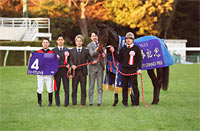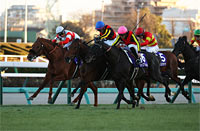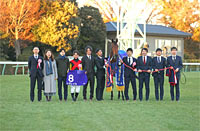Arima Kinen (The Grand Prix) (G1) - Data Analysis
National event with lineup of stellar performers
Last year’s Arima Kinen (The Grand Prix) was won by Chrono Genesis, the runner that had also dominated the Takarazuka Kinen in the same year. Of the 37 race winners since 1984, the year in which the grading system was introduced, 30 had won a JRA G1 race since the previous year. This year, the race promises to unfold once again into a battle between the top performers of the current generation. Which runner will rise to the top in the biggest race of the year-end season, which will be closely watched across the entire country, and close out the year in grand fashion? Let’s now analyze some features shared by successful runners in this race based on results over the last 10 years.
Watch runners’ age and career
Looking at performances by age, we find that 3-year-olds achieved a relatively strong Top 3 ratio of 36.4%. Conversely, horses aged 7 or above failed to produce a single Top 3 finisher, while 6-year-olds had a Top 3 ratio of only 5.9%. In other words, we should raise our expectations of comparatively younger runners. [Table 1]
[Table 1] Performance by age (last 10 years)
| Age |
Performance
[1st-2nd-3rd-4th or lower] |
Win ratio |
Top 2 ratio |
Top 3 ratio |
| 3 |
4-2-2-14 |
18.2% |
27.3% |
36.4% |
| 4 |
2-5-2-36 |
4.4% |
15.6% |
20.0% |
| 5 |
4-3-5-44 |
7.1% |
12.5% |
21.4% |
| 6 |
0-0-1-16 |
0% |
0% |
5.9% |
| 7 or above |
0-0-0-17 |
0% |
0% |
0% |
In addition, of the 30 Top 3 finishers over the last 10 years, 29 had 22 or fewer careers starts. This suggests we should lower our expectations of runners with 23 or more career starts. [Table 2]
[Table 2] Performance by total career starts (last 10 years)
| Total career starts |
Performance
[1st-2nd-3rd-4th or lower] |
Win ratio |
Top 2 ratio |
Top 3 ratio |
| 22 or fewer |
10-10-9-86 |
8.7% |
17.4% |
25.2% |
| 23 or more |
0-0-1-41 |
0% |
0% |
2.4% |
Track record in G1 races is a key factor
Of the 30 Top 3 finishers over the last 10 years, 29 had experience of finishing in the Top 5 of “a JRA G1 race since the previous year.” Conversely, runners without such experience struggled with a Top 3 ratio of 2.3%. In other words, we should lower our expectations of runners that have not yet excelled in G1 races. [Table 3]
[Table 3] Performance by experience of finishing in the Top 5 of “a JRA G1 race since the previous year” (last 10 years)
| Experience |
Performance
[1st-2nd-3rd-4th or lower] |
Win ratio |
Top 2 ratio |
Top 3 ratio |
| Yes |
10-9-10-84 |
8.8% |
16.8% |
25.7% |
| No |
0-1-0-43 |
0% |
2.3% |
2.3% |
In addition, of the 15 Top 3 finishers over the last five years, 13 had experience of winning “a JRA G1 race since the previous year.” These runners also achieved an excellent Top 3 ratio of 46.4%. If trends in recent years are anything to go by, we should focus our attention on runners that have won a G1 race since the previous year. [Table 4]
[Table 4] Performance by experience of winning “a JRA G1 race since the previous year” (last five years)
| Experience |
Performance
[1st-2nd-3rd-4th or lower] |
Win ratio |
Top 2 ratio |
Top 3 ratio |
| Yes |
4-4-5-15 |
14.3% |
28.6% |
46.4% |
| No |
1-1-0-50 |
1.9% |
3.8% |
3.8% |
Strong performers last time out have an edge
Of the 30 Top 3 finishers over the last 10 years, 22 had finished their previous race in the Top 4. Meanwhile, runners that had finished their previous race 5th or lower struggled somewhat with a Top 3 ratio of 10.1%. If we limit our analysis to the last five years since 2016, these runners struggled even more with performance of [0-2-0-38] (Top 3 ratio of 5.0%). In other words, we should focus on runners’ finish in their previous race. [Table 5]
[Table 5] Performance by finish in previous race (last 10 years)
| Finish in previous race |
Performance
[1st-2nd-3rd-4th or lower] |
Win ratio |
Top 2 ratio |
Top 3 ratio |
| Top 4 |
10-5-7-56 |
12.8% |
19.2% |
28.2% |
| 5th or lower |
0-5-3-71 |
0% |
6.3% |
10.1% |
Focus on horses backed by strong favoritism last time out
Of the 21 Top 3 finishers over the last seven years, 18 had contested a domestic race in their previous race, and had been backed as 5th favorite or higher in that race. Conversely, runners that had been backed as 6th favorite or lower last time out struggled with a Top 3 ratio of 2.2%. Up to 2013, many runners that had been backed as 6th favorite or lower delivered strong performance, but if trends in recent years are anything to go by, we should raise our expectations of runners that were highly favored in their previous race. Incidentally, runners that had contested an overseas race last time out achieved performance of [1-0-1-3]. [Table 6]
[Table 6] Among runners that had contested a domestic race in their previous race, performance by favoritism in that race (last seven years)
| Favoritism in previous race |
Performance
[1st-2nd-3rd-4th or lower] |
Win ratio |
Top 2 ratio |
Top 3 ratio |
| 5th favorite or higher |
6-6-6-44 |
9.7% |
19.4% |
29.0% |
| 6th favorite or lower |
0-1-0-44 |
0% |
2.2% |
2.2% |
Closing speed is a decisive factor
Of the 15 Top 3 finishers over the last five years, 11 had been ranked 1st in the estimated time over the final three furlongs in “a 2,000-3,200m JRA graded race in the same year.” Conversely, runners without such experience struggled with a Top 3 ratio of 8.2%. This suggests we should expect little from runners without such experience. [Table 7]
[Table 7] Performance by experience of ranking 1st in the estimated time over the final three furlongs in “a 2,000-3,200m JRA graded race in the same year” (last five years)
| Experience |
Performance
[1st-2nd-3rd-4th or lower] |
Win ratio |
Top 2 ratio |
Top 3 ratio |
| Yes |
5-3-3-20 |
16.1% |
25.8% |
35.5% |
| No |
0-2-2-45 |
0% |
4.1% |
8.2% |
In addition, among runners without experience of ranking 1st in the estimated time over the final three furlongs in “a 2,000-3,200m JRA graded race in the same year” over the last five years, all of the four runners that finished in the Top 3 had experience of ranking 2nd or higher in the estimated time over the final three furlongs in “a 2,200m+ JRA G1 race since the previous year.” We should therefore focus on runners capable of delivering a rapid final sprint. [Table 8]
[Table 8] Among runners without experience of ranking 1st in the estimated time over the final three furlongs in “a 2,000-3,200m JRA graded race in the same year,” performance by experience of ranking 2nd or higher in the estimated time over the final three furlongs in “a 2,200m+ JRA G1 race since the previous year” (last five years)
| Experience |
Performance
[1st-2nd-3rd-4th or lower] |
Win ratio |
Top 2 ratio |
Top 3 ratio |
| Yes |
0-2-2-13 |
0% |
11.8% |
23.5% |
| No |
0-0-0-32 |
0% |
0% |
0% |
Seek out the winner!
Compare factors such as bracket number, age, and career
The last 10 winners all started in Brackets 1-7. Runners starting in Bracket 8 have struggled with performance of [0-0-1-19] (Top 3 ratio 5.0%) since 2011. We should therefore lower our expectations of runners starting in Bracket 8. Other shared features among the last 10 winners were that they were aged 5 or less, that they had 21 or fewer career starts, that they had experience of finishing in the Top 4 of “a JRA G1 race since the previous year,” and that they had finished in the Top 4 of their previous race. In other words, we should also focus on the trends outlined in Table 1, Table 2, Table 3, and Table 5. [Table 9]
[Table 9] Winners’ bracket number, age, total career starts, highest finish in “a JRA G1 race since the previous year,” and finish in the previous race (last 10 years)
| Year |
Winner |
Bracket number |
Age |
Total career starts |
Highest finish in “JRA G1 race since previous year” |
Finish in previous race |
| 2011 |
Orfevre |
6 |
3 |
10 |
1st (2011 Kikuka Sho (Japanese St. Leger), etc.) |
1st |
| 2012 |
Gold Ship |
7 |
3 |
9 |
1st (2012 Kikuka Sho (Japanese St. Leger), etc.) |
1st |
| 2013 |
Orfevre |
3 |
5 |
20 |
1st (2012 Takarazuka Kinen) |
2nd |
| 2014 |
Gentildonna |
2 |
5 |
18 |
1st (2013 Japan Cup) |
4th |
| 2015 |
Gold Actor |
4 |
4 |
12 |
3rd (2014 Kikuka Sho (Japanese St. Leger)) |
1st |
| 2016 |
Satono Diamond |
6 |
3 |
7 |
1st (2016 Kikuka Sho (Japanese St. Leger)) |
1st |
| 2017 |
Kitasan Black |
1 |
5 |
19 |
1st (2017 Tenno Sho (Autumn), etc.) |
3rd |
| 2018 |
Blast Onepiece |
4 |
3 |
6 |
4th (2018 Kikuka Sho (Japanese St. Leger)) |
4th |
| 2019 |
Lys Gracieux |
3 |
5 |
21 |
1st (2019 Takarazuka Kinen, etc.) |
1st |
| 2020 |
Chrono Genesis |
5 |
4 |
12 |
1st (2020 Takarazuka Kinen, etc.) |
3rd |
(Masaya Ibuki)
|



















